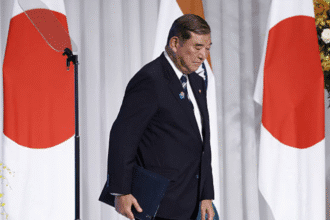China naval drills near Japan have rapidly escalated tensions across the Indo-Pacific region. In a move that surprised many observers, China deployed its two major aircraft carriers — the Shandong and the Liaoning — for simultaneous drills in the western Pacific. This marked the first time China had conducted such coordinated exercises using multiple carriers, signaling a bold display of naval power and operational readiness.
- Why Did Japan Publicly Track and Disclose Chinese Movements?
- How Has China Responded to Japan’s Concerns?
- How Is China Expanding Its Naval Capabilities?
- Is the U.S. Shift to the Middle East Creating Strategic Space?
- What Does This Mean for Regional Stability?
- Conclusion: How Should Regional Powers Respond?
Over several weeks, the Chinese military carried out more than 500 take-offs and landings involving fighter jets and helicopters. These maneuvers were not confined to the open sea. Instead, the aircraft carriers ventured near Japanese islands and entered parts of Japan’s Exclusive Economic Zone (EEZ), areas where Japan maintains special rights to marine resources but does not have sovereignty. Though international law permits freedom of navigation through EEZs, the proximity of the drills raised alarms in Tokyo.
Adding to the urgency, the Liaoning crossed the so-called “second island chain,” a critical strategic line in U.S. military doctrine stretching from Japan to Guam. This was reportedly the first time a Chinese carrier had sailed past this line, further underlining China’s growing ambition to assert naval presence far beyond its traditional waters.
Why Did Japan Publicly Track and Disclose Chinese Movements?
Japan’s Ministry of Defense responded by taking the unusual step of publicly releasing detailed maps tracking the movements of the Chinese carriers. These maps showed daily positions since May 25, revealing how close the vessels came to Japanese territory. This level of transparency is rare for Japan, highlighting the severity of its concerns.
Tokyo also documented several dangerous aerial encounters. On June 7, a Chinese fighter jet took off from the Shandong and closely shadowed a Japanese surveillance aircraft for around 40 minutes. The next day, a similar incident lasted for more than an hour. These actions, according to Japanese officials, represent “abnormal approaches” that increase the risk of accidental collisions.
Chief Cabinet Secretary Yoshimasa Hayashi confirmed that Japan had lodged a formal protest with Beijing, stressing the need for restraint and responsible conduct in the region. The public disclosure of military tracking data was intended not just as a warning to China, but also as a message to international observers about Japan’s commitment to regional stability.
How Has China Responded to Japan’s Concerns?
China swiftly responded by asserting the legality of its drills. According to Chinese Foreign Ministry spokesperson Lin Jian, the China naval drills near Japan were in full compliance with international law and established practices. Lin argued that the real risk to maritime and airspace security came from Japanese and allied forces monitoring routine Chinese exercises.
“It is Japan’s close-in reconnaissance that has triggered maritime and air security risks,” said Lin. Beijing urged Tokyo to cease what it described as “dangerous moves,” and reiterated that China would continue its military activities as planned.
Despite the pointed rhetoric, both countries acknowledged ongoing communication through diplomatic and military channels. While the tone remains tense, this dialogue is a crucial mechanism for avoiding escalation and managing potential flashpoints in an increasingly contested region. Read another article on US-China Trade War Escalates Globally
How Is China Expanding Its Naval Capabilities?
While current drills dominate attention, China also used this period to highlight advances in its naval capabilities. It provided an update on the Fujian, its newest and most advanced aircraft carrier, which is expected to enter service later this year. Unlike its predecessors, the Fujian will use electromagnetic catapults to launch aircraft — a technology only the United States currently employs.
These catapults allow for faster, more efficient aircraft launches, enabling jets to take off with full fuel and weapon loads. Military analysts suggest this could dramatically increase sortie rates and combat readiness. The development of the Fujian demonstrates China’s commitment to modernizing its navy, making future China naval drills near Japan potentially even more sophisticated and far-reaching.
These exercises follow a pattern of growing Chinese military activity beyond its immediate neighborhood. In February, China conducted a major drill in the Tasman Sea, catching Australia and New Zealand off guard. Both countries complained about inadequate advance notice, and some commercial flights were diverted at the last minute. While the exercise was deemed legal, the lack of transparency raised international concern.
Is the U.S. Shift to the Middle East Creating Strategic Space?
Analysts believe the timing of the Chinese naval drills near Japan may not be coincidental. The U.S. recently redeployed the aircraft carrier USS Nimitz from the South China Sea to the Middle East, likely in response to rising tensions between Israel and Iran. This temporary shift in U.S. focus may have created a perceived opening for China to test regional dynamics.
Kazuto Suzuki, a professor at the University of Tokyo, noted that China appears to be “testing the waters” of the U.S.-Japan military alliance. “With U.S. assets concentrating in the Middle East, China sees this as an opportunity to escalate. It’s a calculated move,” he said. Rather than a sudden provocation, Suzuki described the maneuvers as a “step-by-step, gradual escalation,” aimed at identifying potential weaknesses in Japan’s coastal defense.
Fujian’s expected entry into service will further enhance China’s reach. As Beijing continues to invest heavily in military technology, it aims to close the gap with U.S. capabilities while asserting dominance in the Indo-Pacific.
What Does This Mean for Regional Stability?
The China naval drills near Japan are more than just tactical maneuvers; they serve as strategic signals to allies and rivals alike. The United States has reaffirmed its commitment to the Indo-Pacific, with Defense Secretary Pete Hegseth recently stating that the U.S. “will not be pushed out of Asia.”
Still, balancing global commitments remains a challenge. As the U.S. juggles increasing responsibilities in the Middle East, regional partners like Japan may face more pressure to strengthen their own defense posture. Australia, New Zealand, and Southeast Asian nations are also watching closely, wary of how quickly the regional security architecture can shift.
Allies are increasingly calling for stronger collaboration and clearer communication. Multilateral military exercises, enhanced surveillance networks, and diplomatic engagement are becoming essential tools in managing the Indo-Pacific’s complex security environment.
Conclusion: How Should Regional Powers Respond?
In light of the intensified Chinese naval drills near Japan, it is critical for regional stakeholders to remain vigilant, informed, and united. The drills are not isolated events; they reflect China’s evolving military strategy and growing confidence on the world stage.
Strategic alliances, especially between the U.S. and Japan, must be continuously strengthened. Transparent communication, joint military readiness, and respect for international law will be key to preventing miscalculations and preserving peace.








